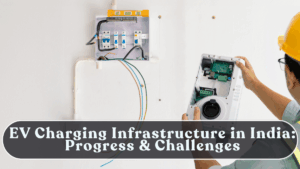The rapid expansion of EV charging infrastructure in India is at the heart of the country’s clean mobility transition. As electric two-wheelers, cars, and commercial vehicles become mainstream, the demand for a robust charging ecosystem has skyrocketed. With more than 1.8 million EVs on Indian roads in 2025, the focus has shifted from sales to infrastructure and convenience. The question isn’t “Will people buy EVs?” anymore — it’s “Where will they charge them?”

India’s Current EV Charging Landscape
As of mid-2025, India has around 20,000 public charging stations, compared to just 2,000 in 2021. The growth is impressive but still modest considering India’s scale and population density.
-
Delhi, Maharashtra, Karnataka, and Tamil Nadu lead in charging installations.
-
Private players like Tata Power, Statiq, and ChargeZone dominate the urban market.
-
Highways now feature fast chargers every 50–60 km, covering major routes like Delhi–Jaipur and Mumbai–Pune.
Despite these developments, charging availability remains clustered in metros, leaving rural and tier-2 cities underserved.
Government Policy and Incentives
The government plays a pivotal role in shaping India’s EV charging infrastructure rollout.
Key initiatives include:
-
FAME-II Scheme: Provides capital incentives of up to ₹1 crore per charging station for public and commercial use.
-
Battery Swapping Policy 2025: Simplifies charging for two- and three-wheelers through swappable battery hubs.
-
National Electric Mobility Mission (NEMMP): Aims to deploy 1 million public chargers by 2030.
-
Energy Ministry Guidelines: Mandate at least one charging station every 3 km in cities and 25 km on highways.
State governments, including Delhi and Maharashtra, also offer electricity tariff reductions for EV charging operators.
Types of EV Charging Stations in India
India’s charging network includes a mix of slow and fast-charging technologies suited for different vehicles and user needs.
| Charger Type | Charging Time | Suitable For | Avg. Cost per Unit (₹) |
|---|---|---|---|
| AC Level 1 | 6–8 hours | Home use, scooters | 6–8 |
| AC Level 2 | 3–4 hours | Cars and bikes | 8–10 |
| DC Fast Charger | 30–45 minutes | Cars, commercial fleets | 12–18 |
| Battery Swapping | <10 minutes | Scooters, 3-wheelers | Subscription-based |
With companies like Tata Power EZ Charge, Ather Grid, and Hero Vida expanding their networks, accessibility has significantly improved in urban centers.
Private Sector and Start-Up Contributions
Private investments have accelerated infrastructure development.
-
Tata Power operates over 6,000 charging points across 400 cities.
-
Ather Energy’s Ather Grid has over 2,500 fast chargers dedicated to two-wheelers.
-
Statiq and ChargeZone focus on commercial charging networks for buses and fleets.
-
BPCL and IOCL are converting thousands of petrol pumps into EV charging hubs.
Collaboration between oil companies, DISCOMs, and EV manufacturers is proving vital for scaling operations efficiently.
Challenges in India’s EV Charging Expansion
Despite progress, several bottlenecks persist in India’s charging ecosystem.
-
High setup cost: Fast chargers cost ₹15–₹25 lakh each, limiting small businesses.
-
Grid stability: Increased load from chargers can stress regional power grids.
-
Land acquisition: Finding accessible public land for stations is challenging in cities.
-
Payment interoperability: Users face compatibility issues between different networks.
-
Low utilization rate: Many chargers remain underused in early-adoption phases.
Overcoming these challenges requires a coordinated public-private approach, along with smart-grid technology integration.
Future Outlook: A Nation on the Move
The roadmap for India’s EV charging network is ambitious but achievable. The NITI Aayog projects a requirement of 46,000 fast chargers and 180,000 slow chargers by 2030. Innovations such as solar-powered stations, wireless charging, and vehicle-to-grid (V2G) systems will redefine energy flow between vehicles and infrastructure.
Partnerships between automakers (like Hyundai, MG, and Tata Motors) and charge-point operators will ensure seamless user experiences — from locating chargers to digital payment integration.
Conclusion
India’s EV charging infrastructure is evolving from pilot projects to a national network capable of supporting mass adoption. While challenges remain in coverage and affordability, the combination of policy support, private investment, and technological innovation ensures steady progress. As India electrifies its roads, charging convenience will become as natural as refueling — marking a true turning point in the country’s clean mobility journey.
FAQs
How many EV charging stations are there in India in 2025?
Around 20,000 public chargers are currently operational, with new installations growing monthly.
Which states lead in EV charging infrastructure?
Delhi, Maharashtra, Karnataka, and Tamil Nadu are the top-performing states.
What’s the cost of installing a fast charger?
A typical DC fast charger setup costs between ₹15–₹25 lakh.
Are there highway EV chargers in India?
Yes, major corridors like Delhi–Jaipur, Mumbai–Pune, and Chennai–Bengaluru now feature fast chargers at regular intervals.
What is the future of EV charging in India?
By 2030, India aims to establish a nationwide fast-charging network, making EV adoption convenient, affordable, and sustainable.
Click here to know more.
